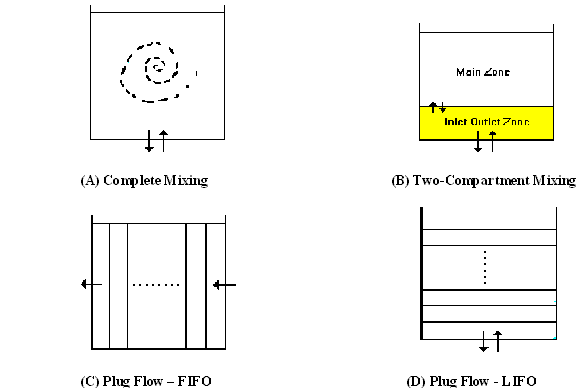EPANet’s water quality simulator can use four different types of models to characterize mixing within storage tanks, as illustrated below:
•Complete Mixing
•Two-Compartment Mixing
•FIFO Plug Flow
•LIFO Plug Flow
Tank Mixing Models

The different models shown above can be used with different tanks within a network.
The Complete Mixing model assumes that all water that enters a tank is instantaneously and completely mixed with the water already in the tank. It is the simplest form of mixing behaviour to assume, requires no extra parameters to describe it, and seems to apply quite well to a large number of facilities that operate in fill-and-draw fashion.
The Two-Compartment Mixing model divides the available storage volume of a tank into two compartments, both of which are assumed completely mixed. The inlet/outlet pipes of the tank are assumed to be located in the first compartment. New water that enters the tank mixes with the water in the first compartment. If this compartment is full, it sends its overflow to the second compartment, where it completely mixes with the water already stored there. When water leaves the tank, it exits from the first compartment, which if full, receives an equivalent amount of water from the second compartment to make up the difference. The first compartment is capable of simulating short-circuiting between inflow and outflow, while the second compartment can represent dead zones. The user must supply a single parameter, which is the fraction of the total tank volume devoted to the first compartment.
The FIFO Plug Flow model assumes that there is no mixing of water at all during its residence time in a tank. Water parcels move through the tank in a segregated fashion, where the first parcel to enter is also the first to leave. Physically speaking, this model is most appropriate for baffled tanks that operate with simultaneous inflow and outflow. There are no additional parameters needed to describe this mixing model.
The LIFO Plug Flow model also assumes that there is no mixing between parcels of water that enter a tank. However, in contrast to FIFO Plug Flow, the water parcels stack up one on top of another, and the last parcel to enter will then be the first to leave. This is found where water enters and leaves the tank at the bottom. This type of model might also apply to a tall, narrow standpipe, with an inlet/outlet pipe at the bottom, and a low momentum inflow. It requires no additional parameters be provided.